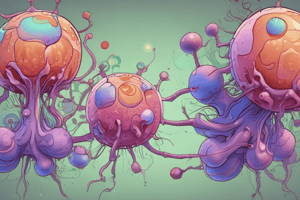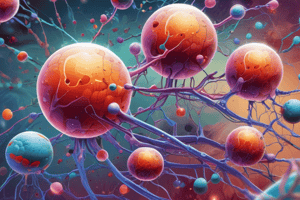Podcast
Questions and Answers
What is the morphologic hallmark of apoptosis?
What is the morphologic hallmark of apoptosis?
- Irregular masses of cytoplasm
- Hypodense nuclear fragments
- Highly basophilic cytoplasm
- Formation of apoptotic bodies (correct)
In which of the following conditions does apoptosis occur?
In which of the following conditions does apoptosis occur?
- Proliferation of cancer cells
- Tissue regeneration after injury
- Hypertrophy of the heart
- Removal of supernumerary cells during embryonic development (correct)
What is the main difference between apoptosis and necrosis?
What is the main difference between apoptosis and necrosis?
- Initiation pathways
- Cellular location of occurrence
- Morphology of cell death
- Involvement of inflammatory response (correct)
Which term describes genetically controlled 'programmed' cell death?
Which term describes genetically controlled 'programmed' cell death?
Which cellular process is responsible for the webbing of fingers or toes during embryogenesis?
Which cellular process is responsible for the webbing of fingers or toes during embryogenesis?
What triggers the execution phase of apoptosis?
What triggers the execution phase of apoptosis?
Which cellular event is controlled by the BCL-2 family members Puma and BAD?
Which cellular event is controlled by the BCL-2 family members Puma and BAD?
What are the structural changes associated with apoptosis?
What are the structural changes associated with apoptosis?
In which condition would defective apoptosis most likely result?
In which condition would defective apoptosis most likely result?
What can result from pathologic atrophy after duct obstruction?
What can result from pathologic atrophy after duct obstruction?
How do necrosis and apoptosis differ in terms of cell size?
How do necrosis and apoptosis differ in terms of cell size?
Which form of cell death begins as apoptosis and finishes as necrosis?
Which form of cell death begins as apoptosis and finishes as necrosis?
What distinguishes pyroptosis from apoptosis?
What distinguishes pyroptosis from apoptosis?
What plays a crucial role in the intrinsic and extrinsic pathways of apoptosis?
What plays a crucial role in the intrinsic and extrinsic pathways of apoptosis?
Which of the following triggers apoptosis?
Which of the following triggers apoptosis?
What is the primary mechanism through which apoptosis is initiated?
What is the primary mechanism through which apoptosis is initiated?
Flashcards are hidden until you start studying
Study Notes
Apoptosis: Mechanism and Pathologic Implications
- Syndactyly is the webbing of fingers or toes due to deficient apoptosis during embryogenesis.
- Apoptosis is initiated through intrinsic or extrinsic pathways, followed by an execution phase.
- Pathologic triggers for apoptosis include DNA damage, accumulation of misfolded proteins, and interaction of cytotoxic T-lymphocytes with host cells.
- Mitochondrial structure and location of cytochrome c play a crucial role in the intrinsic and extrinsic pathways of apoptosis.
- The BCL-2 family members, including Puma and BAD, control the intrinsic pathway by activating proapoptotic proteins and blocking antiapoptotic proteins.
- Structural changes in apoptosis include cell shrinkage, chromatin condensation, formation of apoptotic bodies, and rapid phagocytosis by macrophages.
- Defective apoptosis leads to conditions such as webbed fingers and toes, supernumerary nipples, and increased cell survival in cancer and autoimmune disorders.
- Increased apoptosis can result from DNA damage, accumulation of misfolded proteins, and pathologic atrophy after duct obstruction.
- Necrosis and apoptosis differ in terms of cell size, nucleus condition, plasma membrane integrity, cellular contents, and inflammatory response.
- Necroptosis is a form of "programmed necrosis" that begins as apoptosis and finishes as necrosis, often seen in ischemia-reperfusion injury and neurodegenerative diseases.
- Pyroptosis is a form of inflammatory cell death with distinct mechanisms and implications.
- Apoptosis has pathologic and physiological significance, with implications for various disease conditions and cellular processes.
Studying That Suits You
Use AI to generate personalized quizzes and flashcards to suit your learning preferences.




